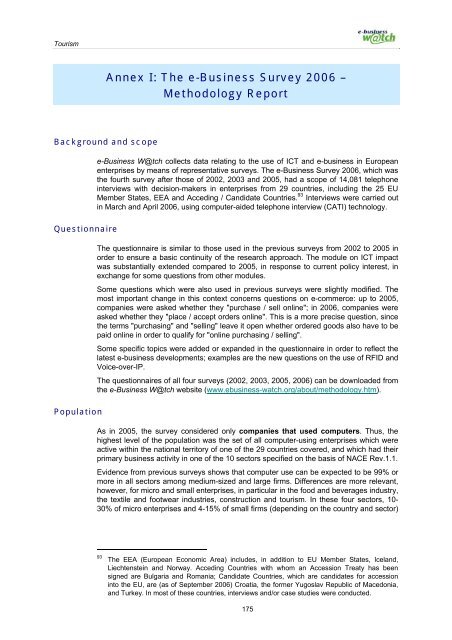ICT and e-business in the tourism industry ICT adoption ... - empirica
ICT and e-business in the tourism industry ICT adoption ... - empirica
ICT and e-business in the tourism industry ICT adoption ... - empirica
Create successful ePaper yourself
Turn your PDF publications into a flip-book with our unique Google optimized e-Paper software.
Tourism<br />
Annex I: The e-Bus<strong>in</strong>ess Survey 2006 –<br />
Methodology Report<br />
Background <strong>and</strong> scope<br />
e-Bus<strong>in</strong>ess W@tch collects data relat<strong>in</strong>g to <strong>the</strong> use of <strong>ICT</strong> <strong>and</strong> e-<strong>bus<strong>in</strong>ess</strong> <strong>in</strong> European<br />
enterprises by means of representative surveys. The e-Bus<strong>in</strong>ess Survey 2006, which was<br />
<strong>the</strong> fourth survey after those of 2002, 2003 <strong>and</strong> 2005, had a scope of 14,081 telephone<br />
<strong>in</strong>terviews with decision-makers <strong>in</strong> enterprises from 29 countries, <strong>in</strong>clud<strong>in</strong>g <strong>the</strong> 25 EU<br />
Member States, EEA <strong>and</strong> Acced<strong>in</strong>g / C<strong>and</strong>idate Countries. 93 Interviews were carried out<br />
<strong>in</strong> March <strong>and</strong> April 2006, us<strong>in</strong>g computer-aided telephone <strong>in</strong>terview (CATI) technology.<br />
Questionnaire<br />
Population<br />
The questionnaire is similar to those used <strong>in</strong> <strong>the</strong> previous surveys from 2002 to 2005 <strong>in</strong><br />
order to ensure a basic cont<strong>in</strong>uity of <strong>the</strong> research approach. The module on <strong>ICT</strong> impact<br />
was substantially extended compared to 2005, <strong>in</strong> response to current policy <strong>in</strong>terest, <strong>in</strong><br />
exchange for some questions from o<strong>the</strong>r modules.<br />
Some questions which were also used <strong>in</strong> previous surveys were slightly modified. The<br />
most important change <strong>in</strong> this context concerns questions on e-commerce: up to 2005,<br />
companies were asked whe<strong>the</strong>r <strong>the</strong>y "purchase / sell onl<strong>in</strong>e"; <strong>in</strong> 2006, companies were<br />
asked whe<strong>the</strong>r <strong>the</strong>y "place / accept orders onl<strong>in</strong>e". This is a more precise question, s<strong>in</strong>ce<br />
<strong>the</strong> terms "purchas<strong>in</strong>g" <strong>and</strong> "sell<strong>in</strong>g" leave it open whe<strong>the</strong>r ordered goods also have to be<br />
paid onl<strong>in</strong>e <strong>in</strong> order to qualify for "onl<strong>in</strong>e purchas<strong>in</strong>g / sell<strong>in</strong>g".<br />
Some specific topics were added or exp<strong>and</strong>ed <strong>in</strong> <strong>the</strong> questionnaire <strong>in</strong> order to reflect <strong>the</strong><br />
latest e-<strong>bus<strong>in</strong>ess</strong> developments; examples are <strong>the</strong> new questions on <strong>the</strong> use of RFID <strong>and</strong><br />
Voice-over-IP.<br />
The questionnaires of all four surveys (2002, 2003, 2005, 2006) can be downloaded from<br />
<strong>the</strong> e-Bus<strong>in</strong>ess W@tch website (www.e<strong>bus<strong>in</strong>ess</strong>-watch.org/about/methodology.htm).<br />
As <strong>in</strong> 2005, <strong>the</strong> survey considered only companies that used computers. Thus, <strong>the</strong><br />
highest level of <strong>the</strong> population was <strong>the</strong> set of all computer-us<strong>in</strong>g enterprises which were<br />
active with<strong>in</strong> <strong>the</strong> national territory of one of <strong>the</strong> 29 countries covered, <strong>and</strong> which had <strong>the</strong>ir<br />
primary <strong>bus<strong>in</strong>ess</strong> activity <strong>in</strong> one of <strong>the</strong> 10 sectors specified on <strong>the</strong> basis of NACE Rev.1.1.<br />
Evidence from previous surveys shows that computer use can be expected to be 99% or<br />
more <strong>in</strong> all sectors among medium-sized <strong>and</strong> large firms. Differences are more relevant,<br />
however, for micro <strong>and</strong> small enterprises, <strong>in</strong> particular <strong>in</strong> <strong>the</strong> food <strong>and</strong> beverages <strong>in</strong>dustry,<br />
<strong>the</strong> textile <strong>and</strong> footwear <strong>in</strong>dustries, construction <strong>and</strong> <strong>tourism</strong>. In <strong>the</strong>se four sectors, 10-<br />
30% of micro enterprises <strong>and</strong> 4-15% of small firms (depend<strong>in</strong>g on <strong>the</strong> country <strong>and</strong> sector)<br />
93<br />
The EEA (European Economic Area) <strong>in</strong>cludes, <strong>in</strong> addition to EU Member States, Icel<strong>and</strong>,<br />
Liechtenste<strong>in</strong> <strong>and</strong> Norway. Acced<strong>in</strong>g Countries with whom an Accession Treaty has been<br />
signed are Bulgaria <strong>and</strong> Romania; C<strong>and</strong>idate Countries, which are c<strong>and</strong>idates for accession<br />
<strong>in</strong>to <strong>the</strong> EU, are (as of September 2006) Croatia, <strong>the</strong> former Yugoslav Republic of Macedonia,<br />
<strong>and</strong> Turkey. In most of <strong>the</strong>se countries, <strong>in</strong>terviews <strong>and</strong>/or case studies were conducted.<br />
175

















